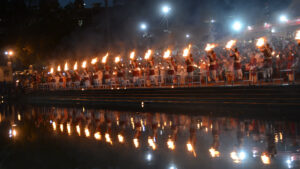Nestled in the foothills of the Himalayas, Uttarakhand is a land of diverse cultures and traditions. Among the various indigenous communities that inhabit this picturesque state, the Tharu tribes stand out for their unique customs, vibrant traditions, and rich cultural heritage. In this blog, we delve into the fascinating world of the Tharu tribes of Uttarakhand, exploring their history, lifestyle, and enduring traditions.
Who Are the Tharu?
The Tharu people are an indigenous ethnic group primarily residing in the Terai region of Uttarakhand, as well as in parts of Uttar Pradesh, Bihar, and Nepal. The Tharu community in Uttarakhand is concentrated in the districts of Udham Singh Nagar and Nainital. They are known for their deep connection with nature, traditional farming practices, and distinct cultural identity.
Historical Background
The origin of the Tharu people is shrouded in mystery, with various theories suggesting they might be descendants of Rajput warriors who fled into the forests to escape persecution. Over centuries, the Tharu tribes have developed a unique way of life that is closely tied to the forested and fertile lands of the Terai region.
Lifestyle and Occupation
The Tharu community primarily practices agriculture, which is the backbone of their economy. They cultivate crops such as rice, wheat, maize, and pulses using traditional farming methods. In addition to agriculture, the Tharu people are skilled in animal husbandry, fishing, and gathering forest produce.
The Tharu villages are characterized by their distinctive thatched-roof houses made of mud, bamboo, and grass. These homes are designed to withstand the humid and rainy climate of the Terai region. The Tharu tribes people have a profound knowledge of herbal medicine and rely on traditional remedies for healthcare.
Cultural Traditions
The Tharu tribes culture is rich with folklore, music, dance, and art. They celebrate various festivals with great enthusiasm, with some of the most notable being:
- Maghi (Makar Sankranti): This harvest festival is celebrated with traditional music, dance, and feasting. It marks the end of winter and the beginning of the new agricultural cycle.
- Jitiya: This festival is observed by Tharu women, who fast and pray for the well-being of their children. It is marked by traditional rituals and community gatherings.
- Diwali and Holi: Like many other communities in India, the Tharu people also celebrate Diwali and Holi with fervor, incorporating their unique customs into the festivities.
Art and Craft
Tharu art and craft are integral parts of their cultural identity. The women of the community are known for their intricate embroidery, weaving, and beadwork. Tharu pottery, basket weaving, and traditional paintings reflect their close association with nature and their artistic skills.
Social Structure
The Tharu tribes community follows a patriarchal social structure, with families living in extended households. They have a strong sense of community and mutual support. Traditional village councils, known as “panchayats,” play a crucial role in resolving disputes and making decisions for the welfare of the community.
Challenges and Preservation
Despite their rich cultural heritage, the Tharu tribes people face several challenges, including land rights issues, limited access to education and healthcare, and the impact of modernization. Efforts are being made by the government and various non-governmental organizations to preserve and promote Tharu tribes culture and improve their socio-economic conditions.
Some OTHER Tribes of Uttarakhand
Uttarakhand, with its diverse geography and rich cultural tapestry, is home to several indigenous tribes, each with unique traditions and ways of life. Here’s an overview of some of the prominent tribes of Uttarakhand:
Buksas Tribes
The Buksa tribe has a vibrant cultural heritage with traditional music, dance, and rituals.
- They are known for their colorful attire and intricate beadwork.
- The Buksa people practice agriculture, focusing on crops like rice, maize, and vegetables.
- Their traditional homes are made from locally available materials, designed to suit the region’s climate.
Raji Tribes
- The Raji tribe is known for its traditional dance forms and oral storytelling.
- They celebrate festivals such as “Magh Mela” and “Holi” with special rituals.
- Traditionally, the Raji are forest dwellers and practice shifting agriculture.
- Their lifestyle is closely intertwined with nature, and they are skilled in using forest resources for their daily needs.
Rathia Tribe
- The Rathia tribe is known for their unique traditional customs, including folk dances and songs.
- Their festivals often include community feasts and ceremonies that reflect their deep connection to nature.
- The Rathia people engage in agriculture and animal husbandry.
- Their homes are typically made from locally sourced materials, reflecting their integration with the environment.
Kumaoni and Garhwali Tribes
- Both communities have rich cultural traditions, including unique dance forms, music, and festivals.
- Kumaoni people are known for their traditional attire, which includes vibrant colors and intricate patterns.
- Garhwali people have a distinct cultural heritage with traditional practices and celebrations.
- Both communities practice agriculture as their primary occupation, growing crops like wheat, rice, and pulses.
- They live in terraced houses adapted to the hilly terrain of Uttarakhand.
Jaunsari Tribe
- The Jaunsari tribe has a rich tradition of folk music, dance, and storytelling.
- They celebrate festivals such as “Magh Mela” with traditional ceremonies and community gatherings.
- The Jaunsari people practice subsistence agriculture, growing crops like barley, maize, and potatoes.
- Their homes are designed to withstand the cold climate of the region and are often built using stone and wood.
Gaddi Tribe
- The Gaddi tribe is known for its pastoral lifestyle and sheep rearing.
- They celebrate various festivals, including “Baisakhi” and “Lohri”, with traditional music and dance.
- The Gaddi people lead a semi-nomadic lifestyle, moving with their livestock between different altitudes according to the season.
- Their homes are portable, designed to be easily assembled and disassembled as they move.
Conclusion
The Tharu tribes of Uttarakhand are a testament to the region’s rich cultural diversity and historical depth. Their unique traditions, vibrant festivals, and deep connection with nature make them an integral part of Uttarakhand’s cultural mosaic. As we learn more about the Tharu community, we gain a deeper appreciation for their enduring heritage and the need to preserve it for future generations. Exploring the world of the Tharu tribes is not just a journey into the past but also a celebration of the living traditions that continue to thrive in the heart of the Himalayas.
Whether you are a cultural enthusiast, a history buff, or a traveler seeking authentic experiences, the Tharu tribes of Uttarakhand offer a fascinating glimpse into a way of life that is both ancient and ever-evolving.
FAQs About the Tharu Tribes of Uttarakhand
1. Who are the Tharu people?
The Tharu people are an indigenous ethnic group primarily residing in the Terai region of Uttarakhand, as well as in parts of Uttar Pradesh, Bihar, and Nepal. They are known for their unique cultural traditions, traditional farming practices, and close connection with nature.
2. Where do the Tharu tribes live in Uttarakhand?
In Uttarakhand, the Tharu tribes are primarily located in the districts of Udham Singh Nagar and Nainital. They inhabit the Terai region, which is characterized by its fertile plains and humid climate.
3. What is the traditional occupation of the Tharu people?
The Tharu people traditionally engage in agriculture, cultivating crops such as rice, wheat, maize, and pulses. They also practice animal husbandry, fishing, and gathering forest produce. Agriculture is the backbone of their economy and way of life.
4. What are some key festivals celebrated by the Tharu community?
- The Tharu community celebrates several festivals, including:
Maghi (Makar Sankranti): A harvest festival marked by traditional music, dance, and feasting. - Jitiya: A festival observed by Tharu women who fast and pray for their children’s well-being.
- Diwali and Holi: Major Hindu festivals celebrated with Tharu customs and traditions.
5. What are some traditional crafts and arts of the Tharu people?
Tharu arts and crafts include intricate embroidery, weaving, and beadwork. They are also known for pottery, basket weaving, and traditional paintings that reflect their close association with nature and their artistic skills.
6. How is Tharu society organized?
Tharu society follows a patriarchal social structure with extended families living together. Traditional village councils, known as “panchayats,” play a key role in resolving disputes and making community decisions.
7. What are the main challenges faced by the Tharu community?
The Tharu community faces challenges such as land rights issues, limited access to education and healthcare, and the impact of modernization. These challenges affect their traditional way of life and socio-economic conditions.





